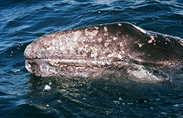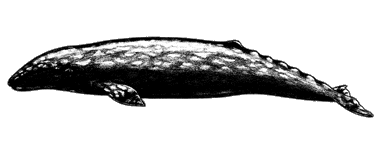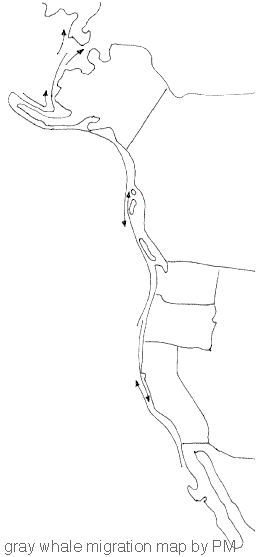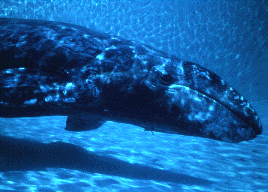All About Gray Whales
By Mona
 |
|
| Gray whale |
![]() he gray whale is a fascinating animal, and
that is why I have written what you are about to read.
You will find out what whales eat, how they migrate, and
other enjoyable facts. You will find information like
from 1924 to 1974, two million whales were killed. Gray
whales as you know are mammals. The gray whale is a part
of the baleen whale
family Eshcrichtiiade and is the only living whale in its
family. I hope you find this information interesting.
he gray whale is a fascinating animal, and
that is why I have written what you are about to read.
You will find out what whales eat, how they migrate, and
other enjoyable facts. You will find information like
from 1924 to 1974, two million whales were killed. Gray
whales as you know are mammals. The gray whale is a part
of the baleen whale
family Eshcrichtiiade and is the only living whale in its
family. I hope you find this information interesting.
Baleen whales are named for the substance that is found in their mouth called baleen. Baleen replaces teeth. The inside of the baleen is frayed to trap food while the outside is smooth. Scientists know them as Mysticeti (pronounced "mis-ti-see-tie"). This word is similar to the Greek word for a mustache, mystax. An interesting fact about the baleen whales is that they all have double blowholes. Baleen whales are said to be the lords of the sea because they are the largest whales.
They roam the ocean far and wide. When they do this they end up at the right place and right time to get what food is needed. Gray whales take a big mouth full of water water and mud from the ocean bottom. They lift their tongue and spray the water through the baleen. It's just like squirting water through your teeth. When the water leaves the mouth they swallow the plankton that is stuck to the baleen.
 |
|
| Gray whale, showing dorsal ridge | |
About 30 million years ago baleen whales appeared. The gray whales that you see today came about 2 million years ago.
Many whales suffered at the hands of humans. People thought whales were terrible beasts, but they were useful for the many products that could be made from them. During several centuries of whaling, thousands of whales died. Many humans were killed too when the whales would turn over their boats because they were scared. After many humans and whales were killed the people realized how gentle the whales can be. In 1970, gray whales were put on the endangered list. Gray whales were taken off the endangered species in 1993.
 Gray whales mate
and feed in the chilly waters of the Bering Sea and the
Arctic Ocean. They migrate from
the Arctic to Baja California, Mexico, where warm lagoons
are found. The 12,000-mile (20,000-km) round trip is the
farthest migration known to man of any mammal.
Gray whales mate
and feed in the chilly waters of the Bering Sea and the
Arctic Ocean. They migrate from
the Arctic to Baja California, Mexico, where warm lagoons
are found. The 12,000-mile (20,000-km) round trip is the
farthest migration known to man of any mammal.
When females give birth it takes place in the shallow warm lagoons of Baja where the male never comes. The baby is called a calf. It has been in the cow (mother) for about a year. A female will circle around and around the mother to make sure no other females come near.
The baby is big and comes tail
first. If it came head first it would drown. It would
never get its first breath. The mother and the other
female push the baby up quickly to fill his lungs with
the first breath of air. The mother dunks his head under
the water then lifts it up and does this repeatedly till
it understands how to keep breathing. Then the mother
will turn on her side and feed her calf warm milk from
her nipples. Unlike cow milk it is yellow. The calf will
drink a gallon before it is full. The baby calf measures
16 ft (4.9m).
 |
|
| Baby gray whale in captivity |
The gray whale has short baleen plates, few
throat grooves and a dorsal hump with little bumps behind. The bones of
gray whale flippers are like those found in the arms and
hands of all mammals, including humans.
 Gray whales can get parasites just like
humans can. Barnacles cling to the whale's skin and eat
plankton (see illustration at right). Humans have lice
but when whales get whale lice, it's a different story --
the lice actually feed on the whale's skin, gross!!
Gray whales can get parasites just like
humans can. Barnacles cling to the whale's skin and eat
plankton (see illustration at right). Humans have lice
but when whales get whale lice, it's a different story --
the lice actually feed on the whale's skin, gross!!
Also, a lot of diseases infect whales' intestines, liver, and stomach. One enemy of the gray whale is the killer whale.
Here are some facts that were not stated earlier, but are interesting to this topic. No one knows if baleen whales use echolocation. Neither do they know the longevity of baleen whales. Just like your ear, a whale's fluke has no bones.
I hope you learned a lot, but to learn even more, go to the official SeaWorld web page about gray whales.
.
Related pages:
| About the author | |
| Related links | |
| Learn about whale books | |
| Read about my trip to the whaling museum | |
| Go to the glossary | |
| Read the bibliography |
![]()
J.J. logo © 1997 SeaWorld, Inc. All rights reserved. Used with permission.


